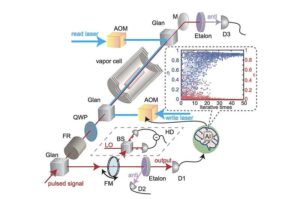
Researchers from China have achieved a significant milestone in quantum memory technology, demonstrating a system that exhibits remarkable efficiency and fidelity. Led by Professor Weiping Zhang from Shanghai Jiao Tong University and Professor Liqing Chen from East China Normal University, the team introduced a new method for controlling atom-light interactions that enhances the storage and retrieval of quantum information. Their findings, published on November 15, 2025, in Physical Review Letters, reveal a Raman quantum memory that achieves an efficiency of 94.6% and a fidelity of 98.91%.
Revolutionizing Quantum Information Storage
The development of quantum memories is a critical area of research as these devices are expected to play a key role in future quantum technologies, including quantum computing and long-distance quantum communication. For a quantum memory to be practical, it must not only store a substantial amount of quantum information—ideally over 90%—but also ensure that the retrieved state matches the original information closely.
Previous attempts at creating efficient quantum memories often resulted in random fluctuations or noise, which compromised the integrity of the stored information. Zhang and Chen’s innovative approach addresses this challenge by utilizing a technique known as the far-off resonant Raman scheme, which allows for improved atom-light interaction control.
A New Approach to Quantum Memory
The researchers’ method incorporates a precise and adaptive technique for managing quantum memory performance. This technique is based on the mathematical principle of atom-light spatiotemporal mapping, specifically the Hankel transform. As Zhang explained, this research is groundbreaking as it reveals the underlying physics of atom-light mapping in quantum memory systems.
“Quantum memory with near-unity efficiency and fidelity is indispensable for quantum information processing,” Zhang stated. “Achieving such a performance has long been a central challenge in the field.”
By applying their mathematical technique to a Raman quantum memory based on warm rubidium-87 vapor, the team successfully overcame the “efficiency-fidelity trade-off” that had previously hindered the development of optimal quantum memories. This breakthrough could pave the way for more advanced quantum technologies that rely on high-performing memory systems.
The implications of this research extend beyond academic interest. Future applications may include integrating these memory systems into quantum repeaters, which are essential for creating fault-tolerant quantum computing networks and enhancing distributed quantum sensing capabilities.
As the field of quantum information science continues to evolve, Zhang and his colleagues plan to explore additional physics-driven principles to further enhance quantum memory technology. This research represents a critical step towards realizing the potential of quantum systems in practical applications.
This article was crafted with contributions from Ingrid Fadelli, edited by Gaby Clark, and reviewed by Robert Egan. The findings underscore the importance of independent science journalism and the continued support of engaged readers.
For further details, see Jinxian Guo et al, “Near-Perfect Broadband Quantum Memory Enabled by Intelligent Spin-Wave Compaction,” Physical Review Letters (2025), DOI: 10.1103/kbwj-md9n.







